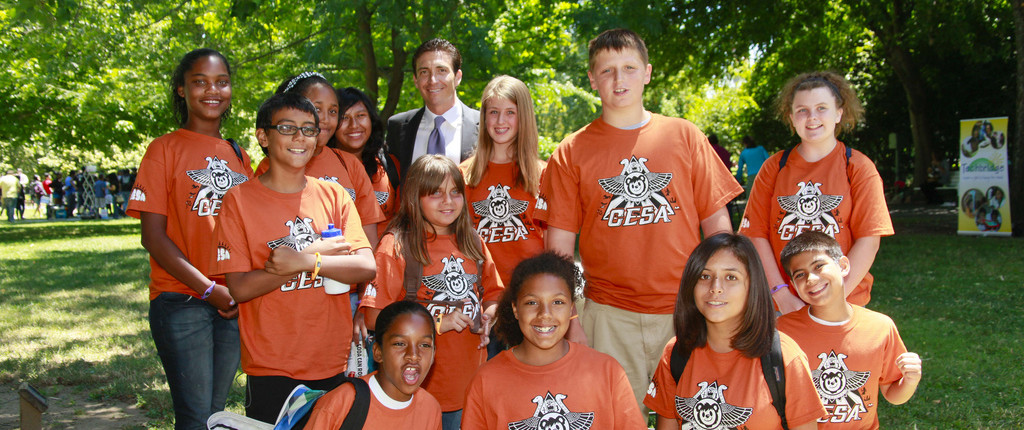Summer and after-school programs—big in California—fight to survive under Trump
By Jessica Calefati, Calmatters.org
Like many of his peers, Kaleb Long is mature enough to stay home alone, but not quite old enough for a part-time job. Had he not enrolled in Rosemont High School’s summer learning program, the 13-year-old predicts he would have spent his Sacramento summer alone, sleeping in and playing video games.
Instead, he took six weeks of publicly-funded classes in entrepreneurship and slam poetry. He learned how to box and picked up tips that should ease his transition to the upper grades. And he started a community project to raise awareness about racism.
“These kids need a safe haven, and we provide one,” said Brianna James, 24, the program’s senior team leader. Participants’ families typically can’t pay for summer enrichment out of pocket, she added. “Without us, the students would have nowhere to go.”
But such federally funded summer and after-school programs—serving more than 100,000 California students, predominantly middle and high schoolers—will be fighting for survival next month as Congress and President Donald Trump start negotiations over the federal budget.
Currently, over 400 programs operating across the state receive about $130 million annually from Washington. But as Trump seeks to shrink the federal government’s role in education, he’s trying to claw back that funding, arguing that the programs don’t actually boost student achievement like they’re supposed to.
After-school advocates, including former Gov. Arnold Schwarzenegger, say that’s not true, and point to research showing that California’s programs have prevented juvenile crime, boosted participants’ graduation rates and improved standardized test scores for students who struggle the most.
“The idea that there’s no evidence showing these programs make a difference is laughable,” said Jennifer Peck, president and CEO of the Oakland-based Partnership for Children and Youth, an after-school advocacy group.
California sees so much promise in after-school programs that for the last decade, following a Schwarzenegger-sponsored ballot initiative, it has invested four times as much in the programs as it gets from the federal government.
But that steady stream of state funding won’t make the cuts Trump is seeking any easier for working families to bear, Peck said.
State funds may only be spent on elementary and middle school students, so California uses most of its federal money on programs for older students. Losing federal funds would likely mean shuttering hundreds of programs like Rosemont’s. Advocates, researchers and state officials all use the same word to describe the impact: devastating.
“These proposed cuts are short-sighted, counterproductive and just wrong,” California Superintendent for Public Instruction Tom Torlakson saidlast month, speaking at a Sacramento-area summer learning program that receives federal funding. “As leaders, we should be searching for ways to help our students thrive, rather than blocking proven paths to success.”
This isn’t the first time federally funded after-school programs, known formally as 21st Century Community Learning Centers, have faced threats of extinction.
Citing research conducted in the early 2000s that found little evidence of program success, President George W. Bush in 2004 sought to cut the centers’ federal funding by more than a third. That effort fizzled when the Mathematica Policy Research findings were widely denounced by other academics.
But at a March press briefing when White House Office of Management and Budget Director Mick Mulvaney defended the deep cuts Trump had proposed, the administration justified his comments with the same decade-old analysis that many regarded as discredited.
“They’re supposed to be educational programs, right? That’s what they’re supposed to do. They’re supposed to help kids who don’t get fed at home get fed so they do better in school, Mulvaney said. “Guess what? There’s no demonstrable evidence they’re actually (improving achievement.) There’s no demonstrable evidence of actually helping results, helping kids do better in school.”
The following month, Schwarzenegger lashed out at Trump during a national after-school summit in Los Angeles.
“President Trump promised us that he wants to make America great again,” Schwarzenegger said. “Why would you want to balance the budget on the backs of those kids? Kids are the most vulnerable citizens. Kids are our future. We need them. That’s why I say every time that you spend money on those kids wisely, you get it back ten times over.”
That claim is supported by Deborah La Torre’s research.
She’s an associate at UCLA’s National Center for Research on Evaluation, Standards and Student Testing and has studied California’s after-school programs closely. La Torre found that the key to success is “dosage.” Students who attended regularly were less likely to transfer, drop out or get suspended from regular school.
“Interacting with caring adults who have degrees can be a big motivator for kids to stay in school,” she said. “There are lots of other things these programs provide besides academic outcomes.”
Shrinking the so-called “opportunity gap” between students from wealthier families and those from disadvantaged ones is one of the programs’ greatest achievements, said Jennifer Rinehart, vice president of policy and research for the Afterschool Alliance, a national advocacy group leading the fight against Trump’s proposal.
“Well-off families can pay for private tutoring, homework help, robotics courses and the like,” Rinehart said. “Many of these kids only get those services through after-school.
What happens when Trump and Congressional leaders meet to hash out a budget deal is anyone’s guess.
“Whether the President’s proposal to eliminate this ineffective federal program ultimately ends up on the chopping block is an open question,” said Lindsey Burke, director of the conservative Heritage Foundation’s center for education policy.
If the programs were working as designed, she said, the country’s standardized test scores wouldn’t be in the middle of the pack compared to other nations.
A spending plan endorsed last month by a House subcommittee seeks more modest cuts to the programs’ federal funding. But federal budget analysts note that the two sides have virtually never been so far apart, with Trump seeking cuts 10 times deeper than those sought by House Republicans.
“We’re not living in normal times,” said David Reich, a senior fellow at the nonpartisan Center on Budget and Policy Priorities. “It’s going to be a long, messy process.”
This story originally appeared on Calmatters.org



